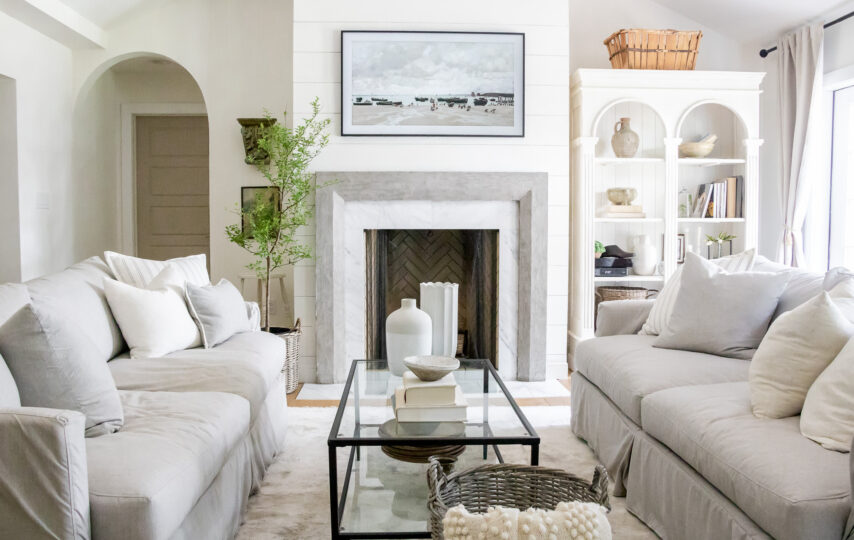Creating a cohesive home design is about more than just filling your space with beautiful furniture; it’s about making sure that every piece, from the living room to the bedroom, works together to create a harmonious look. Achieving this balance can be challenging, especially when you’re dealing with different styles, colors, and functions across various rooms. However, with some thoughtful planning and a few key strategies, you can create a home that feels unified and stylish throughout. Here’s how to match furniture across rooms to establish a cohesive design.
1. Establish a Consistent Color Palette
One of the most effective ways to ensure cohesion in your home design is by establishing a consistent color palette that flows from room to room. This doesn’t mean that every room should be painted the same color or decorated with the same hues, but rather that the colors should complement each other and feel connected.
Start by choosing a primary color that will serve as the foundation of your palette. This color can be used for larger elements such as walls, sofas, and rugs. Then, select a few complementary colors or accent hues to incorporate into smaller pieces like throw pillows, artwork, and decorative accessories.
For example, if your primary color is a soft gray, you might choose accent colors like navy blue and warm gold. In the living room, you could have a gray sofa with navy and gold pillows, while in the bedroom, a navy bedspread with gold accents would tie the rooms together. The key is to repeat these colors in different ways throughout your home to create a sense of unity.
2. Choose a Unifying Style
Another important aspect of creating a cohesive home design is sticking to a unifying style. Whether you prefer modern, traditional, rustic, or eclectic, choosing a dominant style and carrying it through each room will help your home feel cohesive.
To do this, focus on the key characteristics of your chosen style. For instance, if you love mid-century modern design, look for furniture with clean lines, organic shapes, and tapered legs. Incorporate these elements into your living room with a sleek sofa and into your dining room with a minimalist table and chairs.
Even if you mix in a few different styles—perhaps a traditional armchair in the living room or a rustic dresser in the bedroom—keeping the overall design language consistent will maintain harmony across your home. This approach allows you to have variety without sacrificing cohesion.
3. Repeat Textures and Materials
Textures and materials play a crucial role in the look and feel of your home. Repeating the same or similar textures and materials in different rooms can help tie the spaces together.
For example, if your living room features a velvet sofa, you could bring velvet into the bedroom with a velvet headboard or pillows. Similarly, if you have a wooden coffee table in the living room, you might choose wooden nightstands for the bedroom or a wooden dining table. The goal is to create visual connections between rooms through the repetition of textures and materials.
This doesn’t mean that everything has to match exactly—mixing materials can add interest and depth to your design. However, using similar textures and materials in key pieces across different rooms will create a sense of continuity and cohesion.
4. Incorporate Common Patterns
Patterns are another powerful tool for creating cohesion in home design. Just like with colors and materials, repeating patterns in different rooms can help link spaces together.
If you love geometric patterns, for instance, you could use a geometric rug in the living room and echo that pattern in the bedroom with geometric-patterned bedding or curtains. Florals, stripes, or even abstract patterns can work the same way—just be sure to repeat them thoughtfully so that the connection feels intentional.
When mixing patterns, keep the scale and color in mind. A large-scale pattern in one room might be complemented by a smaller-scale version of the same pattern in another room, or by using the pattern in a different color. This strategy keeps the look cohesive without being too repetitive.
5. Use Furniture to Create Flow
The placement of furniture can greatly affect how cohesive your home design feels. To create a sense of flow from room to room, consider the layout and arrangement of your furniture.
One way to do this is by aligning furniture placement with the architecture of your home. For example, if you have a long hallway leading from the living room to the dining room, positioning furniture in a way that guides the eye along that path will help create a natural flow. Similarly, placing key pieces like sofas, tables, and beds in a way that complements the lines of your home’s architecture can enhance the overall sense of cohesion.
Additionally, using similar types of furniture in different rooms can also help create flow. For instance, if you have a modern sectional in the living room, a modern dining set in the adjacent dining room will tie the spaces together. This doesn’t mean that every piece of furniture needs to be the same, but keeping a consistent design language will make your home feel more unified.
6. Focus on Transitional Spaces
Transitional spaces like hallways, entryways, and staircases play a key role in connecting different rooms and maintaining a cohesive design. These often-overlooked areas can serve as a bridge between rooms, helping to tie together different design elements.
Consider how you can use color, style, and materials in these spaces to create continuity. For example, if your living room and dining room are connected by a hallway, you could paint the hallway walls in one of the accent colors used in both rooms. Adding a runner that incorporates patterns or colors from the adjacent rooms can also help transition the design smoothly.
Decorating transitional spaces with artwork, lighting, or small furniture pieces that reflect the design of surrounding rooms can further enhance the cohesive feel of your home. These spaces may be small, but they’re important for the overall flow of your design.
7. Personalize with Accessories
While maintaining cohesion is important, it’s also essential to personalize your space with accessories that reflect your personality and lifestyle. Accessories are a great way to add character to your home without disrupting the overall design harmony.
Choose accessories that complement your established color palette and style. For example, if your home features a modern design with a neutral color scheme, you might add pops of color with vibrant artwork, decorative pillows, or unique sculptures. These accessories can vary from room to room, but maintaining a consistent color or material will ensure they contribute to the cohesive design.
When selecting accessories, consider how they can help link different rooms. A set of matching vases displayed in both the living room and bedroom, or a collection of artwork with a common theme, can subtly tie spaces together while adding a personal touch.
8. Lighting for Unity
Lighting is often overlooked in home design, but it’s a critical element for creating a cohesive look. Consistent lighting fixtures or styles across rooms can tie your design together and ensure that your home feels unified.
For instance, if you prefer a minimalist look, choosing simple, streamlined lighting fixtures throughout your home will maintain that aesthetic. Alternatively, if you’re going for a more eclectic style, you might mix and match lighting fixtures, but keep a consistent theme such as vintage or industrial to maintain cohesion.
Layered lighting—using a mix of ambient, task, and accent lighting—can also enhance the overall design. Ensure that your lighting choices complement the colors, materials, and styles in each room, creating a harmonious ambiance.
9. Conclusion
Creating a cohesive home design that flows seamlessly from one room to the next requires thoughtful planning and attention to detail. By establishing a consistent color palette, choosing a unifying style, repeating textures and patterns, and focusing on transitional spaces, you can create a home that feels connected and harmonious. Personalizing with accessories and selecting cohesive lighting further enhance the unity of your design. Whether you’re starting from scratch or updating your current home, these tips will help you create a space that is not only beautiful but also cohesive and inviting.
If you’re looking for quality furniture to help bring your cohesive design vision to life, you might find it helpful to check out Coleman Furniture, which offers a wide selection of styles and pieces to suit any home.







